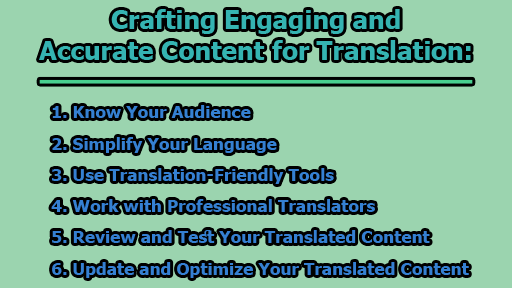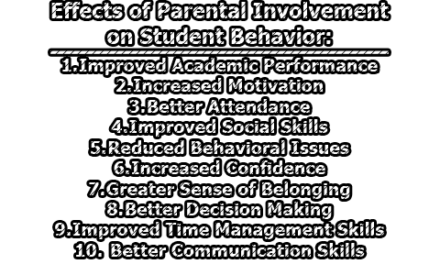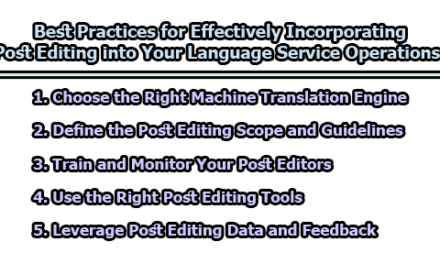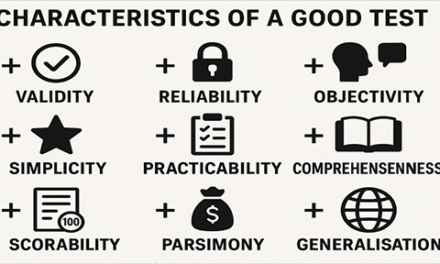Crafting Engaging and Accurate Content for Translation:
Creating content that resonates with your target audience is a challenge that content marketers must overcome. When that content needs to be translated into multiple languages and adapted for various cultures, the stakes are raised considerably. In this article, we will explore crafting engaging and accurate content for translation, ultimately enabling you to connect with a broader global audience.
1. Know Your Audience: Understanding your audience is the cornerstone of creating content that can be effectively translated. It’s essential to ask yourself: Who are you writing for? What are their unique needs, preferences, and expectations? How do they consume content? These questions will help you tailor your content to your target audience and avoid assumptions, jargon, or cultural references that may not translate well or, worse, cause offense.
To create engaging and accurate content for translation, consider your audience’s familiarity with your topic and industry, their tone and style preferences, and the cultural nuances that might affect your messaging.
2. Simplify Your Language: Simplicity is key when it comes to preparing content for translation. This doesn’t mean diluting your message or losing your brand’s distinctive voice. Instead, it involves using clear, concise, and consistent language. Avoid lengthy and complex sentences, passive voice, idioms, slang, and ambiguous terms that might not have direct translations in other languages. Choose straightforward words and phrases that effectively convey your message.
Simplifying your content goes beyond language. Use formatting techniques such as headings, subheadings, lists, and bullet points to make your content more scannable and reader-friendly. This not only benefits your original content but also aids translators in maintaining clarity and structure when translating into different languages.
3. Use Translation-Friendly Tools: To streamline the translation process and maintain quality and consistency, leverage translation-friendly tools. Examples include:
- Content Management Systems (CMS) that support multilingual content and integrate with translation software or services.
- A style guide that defines the tone, voice, terminology, and formatting for both original and translated content.
- A glossary that lists and explains key terms and concepts, aiding translators and readers.
- Translation Memory (TM) systems that store and reuse previous translations, reducing translation time and costs.
These tools will not only facilitate the translation process but also ensure that your content maintains a consistent voice and tone across different languages.
4. Work with Professional Translators: One of the most crucial steps in creating engaging and accurate content for translation is to collaborate with professional translators. These experts are not only fluent in the languages they translate but also possess cultural and market knowledge. They can help adapt your content to meet linguistic, cultural, and technical requirements specific to your target languages and regions. Additionally, professional translators can provide valuable feedback to enhance your content, avoiding errors, misunderstandings, or mistranslations.
5. Review and Test Your Translated Content: To ensure the quality and accuracy of your translated content, invest time in reviewing and testing it. Employ proofreaders or editors to check for accuracy, clarity, grammar, spelling, punctuation, and style. Native speakers or subject matter experts can verify relevance, appropriateness, and correctness. Furthermore, user testing can assess functionality, usability, and overall performance of your translated content.
These steps are crucial for delivering a polished product that accurately conveys your intended message to your target audience.
6. Update and Optimize Your Translated Content: The final step in crafting engaging and accurate content for translation is to continuously update and optimize your translated content. This helps keep it fresh, relevant, and effective. Monitor performance and user feedback, making necessary adjustments accordingly. Implement SEO best practices and relevant keywords to improve visibility and search engine ranking. Leverage analytics tools to measure content impact and ROI, pinpoint areas for improvement, and adapt your content accordingly.
In conclusion, creating content that is both engaging and accurate for translation is a complex process, but one that is essential for expanding your reach in a global market. By understanding your audience, simplifying your language, using translation-friendly tools, working with professional translators, and rigorously reviewing and testing your content, you can craft content that resonates with diverse audiences around the world. Regular updates and optimization ensure that your translated content remains effective and aligned with your objectives.

Library Lecturer at Nurul Amin Degree College










